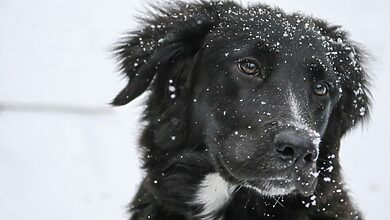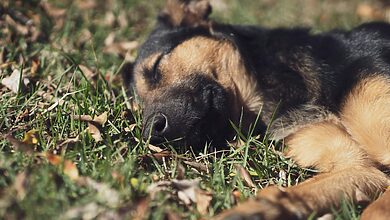Seborrheic Dermatitis in Dogs: Is Your Breed at Risk? 3 Signs to Watch For!

Seborrheic dermatitis in dogs is a common skin condition that can cause discomfort and lead to more severe health issues if not properly managed. While any dog can develop seborrheic dermatitis, certain breeds are more predisposed to this condition due to genetic factors. This article will help you identify if your dog’s breed is at risk and the signs to watch for to ensure timely and effective treatment.
Does your furry friend seem less playful lately? Excessive scratching, a dull, flaky coat, and that persistent doggy odor – these could be signs of seborrheic dermatitis, a common skin condition affecting many canine companions. But fear not, pet parents! Here, we’ll delve into the world of seborrheic dermatitis in dogs, shedding light on this sometimes confusing condition.
We’ll explore the different types of seborrheic dermatitis, uncover the potential causes, and break down the telltale signs to watch out for. More importantly, we’ll equip you with the knowledge to manage this condition effectively and keep your pup feeling comfortable and looking their best.
Whether you’re facing a recent diagnosis or simply want to be proactive about your dog’s well-being, this guide is here to empower you with knowledge. So, grab a comfy spot on the couch with your furry friend by your side, and let’s embark on this journey together!
Understanding Seborrheic Dermatitis in Dogs
What is Seborrheic Dermatitis?
Seborrheic dermatitis is a condition where the sebaceous glands in a dog’s skin produce excessive sebum, leading to either oily or dry, flaky skin. This condition is not only uncomfortable for dogs but can also be indicative of underlying health issues.
Types of Seborrheic Dermatitis
There are two main types of seborrheic dermatitis in dogs:
- Oily Seborrhea (Seborrhea Oleosa): Characterized by greasy skin and fur, oily seborrhea often results in a distinct, unpleasant odor.
- Dry Seborrhea (Seborrhea Sicca): Marked by dry, flaky skin, resembling dandruff.
Primary and Secondary Seborrhea
- Primary Seborrhea: This is a genetic condition seen in certain breeds, such as Cocker Spaniels, West Highland White Terriers, and Basset Hounds.
- Secondary Seborrhea: This form is more common and results from underlying conditions such as allergies, hormonal imbalances, or infections.
Causes of Seborrheic Dermatitis in Dogs
Understanding the root causes of seborrheic dermatitis is crucial for effective treatment. Common causes include:
- Genetic Predisposition: Certain breeds are more susceptible due to their genetic makeup.
- Allergies: Food allergies, environmental allergens, and flea allergies can trigger seborrhea.
- Hormonal Imbalances: Conditions like hypothyroidism and Cushing’s disease can lead to seborrheic dermatitis.
- Infections: Bacterial and fungal infections can exacerbate seborrhea.
- Nutritional Deficiencies: A poor diet lacking essential nutrients can contribute to skin issues.

Breeds Prone to Seborrheic Dermatitis
Genetic Predisposition
Some dog breeds are genetically predisposed to developing seborrheic dermatitis. Knowing whether your breed falls into this category can help you take proactive measures to manage their skin health. Breeds commonly affected by seborrheic dermatitis include:
- Cocker Spaniels: Prone to both oily and dry seborrhea, Cocker Spaniels often require regular grooming and skin care.
- West Highland White Terriers: Known for their sensitive skin, Westies can develop seborrheic dermatitis, especially around their face and legs.
- Basset Hounds: Their droopy ears and skin folds make Basset Hounds susceptible to oily seborrhea and secondary infections.
- English Bulldogs: With their numerous skin folds, Bulldogs are at risk for seborrheic dermatitis and other skin conditions.
- German Shepherds: This breed can develop dry seborrhea, often exacerbated by environmental factors and allergies.
Mixed Breeds
While purebred dogs are more commonly associated with genetic predispositions, mixed breeds with ancestry from susceptible breeds may also be at risk. If your mixed breed dog shows signs of seborrheic dermatitis, it’s essential to consider their genetic background and consult your vet for proper diagnosis and treatment.
Recognizing the 3 Signs of Seborrheic Dermatitis
Oily or Greasy Fur
One of the most noticeable signs of seborrheic dermatitis is oily or greasy fur. If your dog’s coat feels excessively oily or looks shiny and dirty soon after bathing, this could indicate oily seborrhea. Additionally, an unpleasant “doggy odor” often accompanies oily seborrhea, even with regular grooming.
Dry, Flaky Skin
Dry seborrhea, or seborrhea sicca, manifests as dry, flaky skin, resembling dandruff. You might notice white flakes on your dog’s fur, bedding, or around the house. This condition can cause itching and discomfort, leading your dog to scratch or lick excessively, further irritating the skin.
Persistent Itching and Scratching
Seborrheic dermatitis often causes intense itching, leading to persistent scratching, licking, and chewing. This behavior can result in red, inflamed skin, hair loss, and even secondary infections if left untreated. Common areas affected include the face, ears, armpits, belly, and legs.
Resources:
- PetMD: Seborrhea in Dogs
- American Kennel Club: Dog Skin Conditions
Steps to Take if You Notice Signs
Veterinary Consultation
If you observe any of the above signs in your dog, it’s crucial to schedule a veterinary appointment. Your vet will perform a thorough examination, possibly including skin scrapings, cytology, and allergy testing, to diagnose seborrheic dermatitis accurately and identify any underlying causes.
Regular Grooming
Maintaining a regular grooming routine is essential for managing seborrheic dermatitis. Use hypoallergenic or medicated shampoos designed for seborrheic dermatitis to help control oil production and soothe irritated skin. Regular brushing helps remove flakes and distribute natural oils, promoting healthier skin and coat.
Dietary Adjustments
A balanced diet rich in essential fatty acids, vitamins, and minerals is vital for maintaining skin health. Consult your vet to determine if a hypoallergenic or specially formulated diet might benefit your dog. Omega-3 and omega-6 supplements can also help reduce inflammation and improve skin condition.
Medications and Treatments
Depending on the severity of the condition, your vet may prescribe medications such as antibiotics, antifungals, or steroids to treat secondary infections and reduce inflammation. Topical treatments like coconut oil can provide additional relief for dry, irritated skin.
Resources:
- PetMD: Best Dog Foods for Skin Allergies
- VCA Hospitals: Omega-3 Fatty Acids for Dogs
- PetMD: Medicated Shampoos for Dogs

Natural Remedies for Seborrheic Dermatitis in Dogs
Coconut Oil
Coconut oil is a natural moisturizer that can help soothe dry, flaky skin and reduce itching. It has antibacterial and antifungal properties that can aid in preventing secondary infections. To use, gently massage a small amount of coconut oil into your dog’s skin and coat, paying special attention to affected areas.
Oatmeal Baths
Oatmeal is known for its soothing properties and can help relieve itching and irritation associated with seborrheic dermatitis. You can create an oatmeal bath by grinding plain oatmeal into a fine powder and adding it to your dog’s bathwater. Let your dog soak for 10-15 minutes to allow the oatmeal to work its magic.
Apple Cider Vinegar
Apple cider vinegar has antifungal and antibacterial properties that can help combat skin infections. It also helps restore the skin’s natural pH balance. Dilute apple cider vinegar with an equal amount of water and apply it to your dog’s skin using a spray bottle or a clean cloth. Be cautious to avoid open wounds or sores.
Aloe Vera
Aloe vera is known for its soothing and healing properties. It can help reduce inflammation and provide relief from itching. Use pure aloe vera gel and apply it directly to your dog’s affected skin. Ensure that the aloe vera product is free from additives and preservatives.
Fish Oil Supplements
Fish oil supplements are rich in omega-3 fatty acids, which can help reduce inflammation and improve overall skin health. Adding fish oil to your dog’s diet can help alleviate symptoms of seborrheic dermatitis. Consult your vet for the appropriate dosage based on your dog’s size and condition.
Chamomile Tea
Chamomile has anti-inflammatory and calming properties that can help soothe irritated skin. Brew a strong chamomile tea, let it cool, and use it as a rinse for your dog’s skin. You can also soak a clean cloth in the tea and apply it to the affected areas.
Epsom Salt Baths
Epsom salt can help reduce inflammation and relieve itching. Add Epsom salt to your dog’s bathwater and let them soak for 10-15 minutes. Be sure to rinse thoroughly afterward to remove any residual salt.
Resources:
- PetMD: Natural Remedies for Dogs
- American Kennel Club: Coconut Oil for Dogs
- VCA Hospitals: Fish Oil for Pets
Additional Resources
- PetMD: Seborrhea in Dogs
- American Kennel Club: Dog Skin Conditions
- VCA Hospitals: Skin Disease in Dogs
Symptoms of Seborrheic Dermatitis in Dogs
Recognizing the symptoms of seborrheic dermatitis is the first step towards managing the condition. Symptoms can vary depending on the type of seborrhea and its severity.
Common Symptoms
- Greasy Fur: Oily seborrhea often results in greasy, oily fur.
- Flaky Skin: Dry seborrhea is characterized by flaky, dandruff-like skin.
- Itching and Scratching: Dogs with seborrheic dermatitis often experience intense itching.
- Red, Inflamed Skin: The affected areas may become red and inflamed.
- Doggy Odor: A distinct, unpleasant odor is often associated with oily seborrhea.
- Hair Loss: Patchy hair loss can occur due to excessive scratching and inflammation.
Secondary Symptoms
If left untreated, seborrheic dermatitis can lead to secondary symptoms such as:
- Skin Infections: Bacterial or fungal infections may develop in the affected areas.
- Crusting and Scaling: Severe cases may result in thick crusts and scales on the skin.
- Hot Spots: Persistent scratching can lead to hot spots, which are painful, inflamed areas on the skin.
Diagnosing Seborrheic Dermatitis in Dogs
Accurate diagnosis is essential for effective treatment. Your veterinarian will perform a thorough examination and may recommend the following diagnostic tests:
Physical Examination
A physical examination will help your vet identify the characteristic signs of seborrheic dermatitis, such as greasy or flaky skin, redness, and inflammation.
Skin Scrapings and Cytology
Skin scrapings and cytology involve collecting samples from the affected areas and examining them under a microscope. This helps identify any secondary infections and rule out other skin conditions.
Allergy Testing
Allergy testing may be necessary to determine if your dog has underlying allergies contributing to seborrhea. This can include blood tests or intradermal skin testing.
Hormonal Testing
Hormonal imbalances like hypothyroidism or Cushing’s disease can be diagnosed through blood tests. Addressing these conditions is crucial for managing seborrheic dermatitis.
Nutritional Assessment
Your vet may evaluate your dog’s diet and recommend changes to ensure they receive all essential nutrients for healthy skin.

Treatment for Seborrheic Dermatitis in Dogs
Effective treatment for seborrheic dermatitis involves addressing the underlying cause and providing symptomatic relief. Here are some treatment options:
Medicated Shampoos
Medicated Shampoo for Seborrheic Dermatitis: Special shampoos containing ingredients like sulfur, salicylic acid, or benzoyl peroxide can help manage seborrhea. These shampoos help remove excess oil, flakes, and debris while providing relief from itching.
Oatmeal Baths for Dogs with Seborrheic Dermatitis: Oatmeal baths can soothe itchy, inflamed skin. Oatmeal has anti-inflammatory properties and helps moisturize dry, flaky skin.
Resources:
- PetMD: Medicated Shampoos for Dogs
- American Kennel Club: Oatmeal Baths for Dogs
Topical Treatments
Coconut Oil for Dog Skin Problems: Coconut oil has moisturizing and anti-inflammatory properties. Applying a small amount to affected areas can help soothe dry, irritated skin.
Resources:
- PetMD: Coconut Oil for Dogs
Dietary Changes
Dog Food for Seborrheic Dermatitis: Switching to a high-quality diet that includes essential fatty acids, vitamins, and minerals can improve skin health. Hypoallergenic diets may be recommended for dogs with food allergies.
Resources:
- PetMD: Best Dog Foods for Skin Allergies
Supplements
Omega-3 and Omega-6 Fatty Acids: These supplements can help reduce inflammation and improve skin and coat health. Fish oil is a common source of these beneficial fatty acids.
Resources:
Medications
Antibiotics and Antifungals: If secondary bacterial or fungal infections are present, your vet may prescribe antibiotics or antifungal medications.
Steroids: In severe cases, steroids may be prescribed to reduce inflammation and provide relief from itching.
Managing Allergies
Managing Allergies in Dogs with Seborrheic Dermatitis: Identifying and managing allergies is crucial for preventing flare-ups. This may involve allergy testing, avoiding allergens, and using antihistamines or other medications.
Resources:
- American Kennel Club: Allergies in Dogs
Preventing Seborrheic Dermatitis Flare-Ups
Prevention is key to managing seborrheic dermatitis in dogs. Here are some tips to help prevent flare-ups:
Regular Grooming
Regular grooming helps remove excess oil, flakes, and debris from your dog’s coat. Use a gentle, hypoallergenic shampoo and brush your dog regularly to prevent matting and distribute natural oils.
Resources:
Diet and Nutrition
Ensure your dog is on a balanced diet that includes essential fatty acids, vitamins, and minerals. Consult your vet for dietary recommendations tailored to your dog’s needs.
Regular Veterinary Checkups
Regular veterinary checkups can help identify and address any underlying health issues that may contribute to seborrheic dermatitis.
Resources:
- American Veterinary Medical Association: Preventive Care
Allergen Management
Identify and manage potential allergens in your dog’s environment. This may include using hypoallergenic bedding, avoiding certain foods, and minimizing exposure to environmental allergens.
Stress Management
Stress can exacerbate seborrheic dermatitis. Ensure your dog has a calm and stress-free environment, and consider using calming aids if necessary.
Resources:
- PetMD: Calming Aids for Dogs

Special Considerations
Seborrheic Dermatitis in Puppies
Puppies can develop seborrheic dermatitis, often due to genetic factors or nutritional deficiencies. Ensure your puppy receives a balanced diet and consult your vet for appropriate treatment options.
Seborrheic Dermatitis in Senior Dogs
Senior dogs may be more prone to seborrheic dermatitis due to underlying health issues and decreased immune function. Regular veterinary checkups and a balanced diet are essential for managing the condition in older dogs.
Seborrheic Dermatitis
Seborrheic dermatitis in dogs is a manageable condition, especially when caught early and treated effectively. By understanding the risk factors associated with your dog’s breed and recognizing the key signs of seborrheic dermatitis, you can take proactive steps to maintain your dog’s skin health. Regular veterinary care, grooming, dietary adjustments, and appropriate treatments are crucial for managing seborrheic dermatitis and ensuring your dog’s comfort and well-being.
We’ve covered a lot of ground when it comes to seborrheic dermatitis in dogs. Remember, a healthy coat is a happy coat! By understanding the different types of seborrheic dermatitis, the potential causes, and the key signs, you’re well on your way to effectively managing this condition. From exploring dietary changes and medicated shampoos to implementing regular grooming routines, we’ve provided a toolbox of solutions to keep your dog comfortable and their fur looking healthy.
Of course, every dog is an individual, and if you have any concerns about your pet’s skin health or suspect seborrheic dermatitis, always consult your veterinarian. They can provide a personalized diagnosis and treatment plan specific to your dog’s needs.
So, armed with this knowledge, go forth and shower your dog with love, healthy meals, and gentle grooming sessions. Together, you can create a happy and itch-free life for your precious pup!
Additional Resources
- PetMD: Seborrhea in Dogs
- VCA Hospitals: Skin Disease in Dogs
By staying informed and proactive, you can ensure your dog receives the best possible care for seborrheic dermatitis, leading to a happier and healthier life.
Seborrheic Dermatitis in Dogs: Frequently Asked Questions
1. What are the different types of seborrheic dermatitis in dogs?
There are two main types: oily seborrhea, characterized by greasy fur and a strong odor, and dry seborrhea, which causes dandruff and flaky skin. Some dogs even experience a combination of both.
2. What causes seborrheic dermatitis in dogs?
The exact cause is unknown, but it can be linked to underlying allergies, hormonal imbalances, nutritional deficiencies, or even certain dog breeds being predisposed.
3. What are the signs of seborrheic dermatitis in dogs?
Look out for excessive scratching, redness and inflammation of the skin, a dull coat with dandruff or flakes, greasy fur with a doggy odor, and potential hair loss in affected areas.
4. How is seborrheic dermatitis diagnosed in dogs?
Veterinarians typically diagnose seborrheic dermatitis through a physical examination, skin scrapings, and sometimes blood tests to rule out other conditions.
5. How is seborrheic dermatitis treated in dogs?
Treatment depends on the severity and type of seborrheic dermatitis. It can involve medicated shampoos, dietary changes with fatty acid supplements, addressing underlying allergies, or in severe cases, medication.
6. Can I use a special shampoo for my dog’s seborrheic dermatitis?
Yes, medicated shampoos recommended by your veterinarian can help soothe irritation, remove excess oil or flakes, and promote healing.
7. Is there a special food for dogs with seborrheic dermatitis?
While there’s no single “seborrheic dermatitis diet,” a veterinarian might recommend a food rich in omega-3 and omega-6 fatty acids to improve skin health.
8. How can I prevent flare-ups of seborrheic dermatitis in my dog?
Regular grooming, a healthy diet, and managing allergies can all help reduce the risk of flare-ups.
9. Is seborrheic dermatitis contagious to other dogs or humans?
No, seborrheic dermatitis is not contagious.
10. Should I see a veterinarian if my dog has itchy skin and dandruff?
Absolutely! While seborrheic dermatitis is a common cause, other skin conditions can have similar symptoms. A veterinarian can provide a proper diagnosis and treatment plan.







